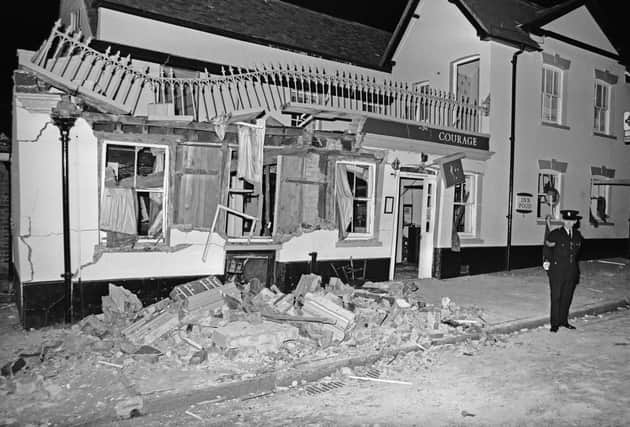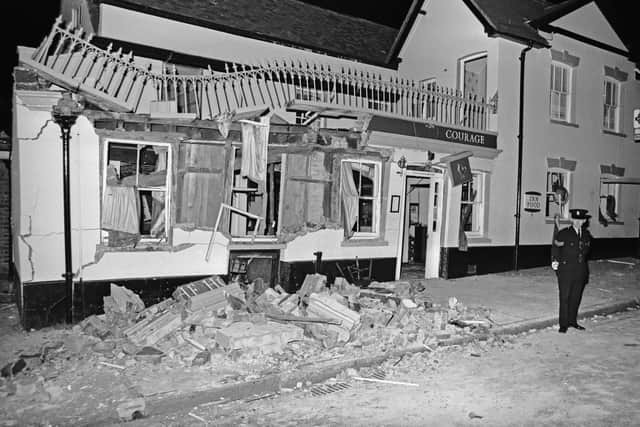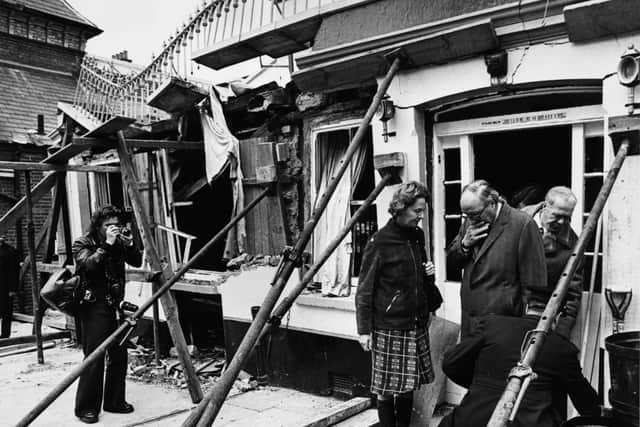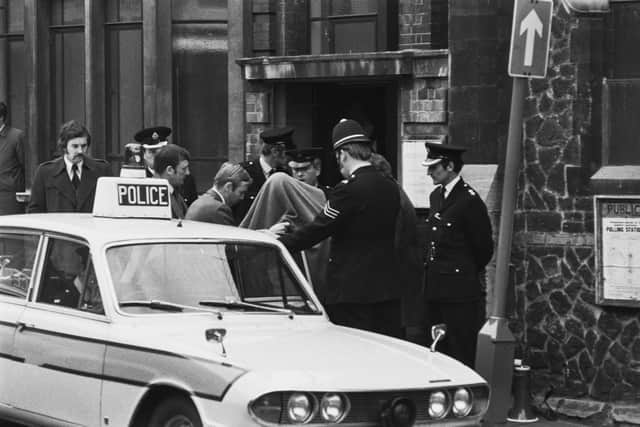Guildford pub bombing: what happened during 1974 IRA attack - who died and what did the inquest say?


An inquest into the IRA bombing of a Guildford pub almost 48 years has concluded.
The attack took place at the Horse and Groom pub in 1974 and led to the death of five people.
Advertisement
Hide AdAdvertisement
Hide AdSurrey Coroner’s Court has now heard that the five victims had been “unlawfully” killed in the explosion.


What happened in the Guildford pub bombing?
The bomb was set off in the Horse and Groom pub on North Street in the Surrey town of Guildford on 5 October 1975.
The attack took place at the height of the Northern Ireland Troubles, with the Irish Republican Army (IRA) targeting the pub due to its popularity with British soldiers who were situated at the nearby Pirbright barracks.
Two six-pound gelignite bombs were used in the attack.


The explosive devices, which were believed to be the equivalent of 18 sticks of dynamite, were detonated between 8.30pm and 9pm.
Advertisement
Hide AdAdvertisement
Hide AdIt is believed that around 120 people were inside the building at the time of the first explosion.
The attack led to 65 people being injured, 30 of which were seriously injured.
Who died in the Guildford pub bombing?
Five people died in the attack on the Horse and Groom pub.
This included four off-duty soldiers and one civilian.
18-year-old Caroline Slater and 19-year-old Ann Hamilton, members of the Women’s Royal Army Corps, died, alongside two soldiers from the Scots Guard - William Forsyth, 18, and John Hunter, 17.
21-year-old civilian Paul Craig was also killed in the attack.
Who was convicted for the Guildford pub bombing?
Advertisement
Hide AdAdvertisement
Hide AdThe IRA claimed responsibility for the bombing and became the first in a series of attacks perpetrated by an active service unit known as the Balcombe Street Gang.
In December 1974, police arrested three men and one woman for the attack on the Horse and Groom.
Those arrested were Paul Hill, Gerry Conlon, Paddy Armstrong and Carole Richardson.
This group of suspects became known as the ‘Guildford Four’.
Advertisement
Hide AdAdvertisement
Hide AdAll four were wrongly convicted and sentenced to life for the bombings in October 1975.


After serving 15 years in prison, Hill, Conlon, Armstrong and Richardson were released after their convictions were overturned.
This was due to the fact that their convictions had been based on confessions obtained through torture methods, while evidence which cleared them of any wrongdoingwas now recorded by police.
Police had also arrested a group of Conlon’s relatives in connection with supplying the materials to make the bombs. The group who became known as the Maguire Seven, included his father Giuseppe Conlon. It also included Giuseppe’s sister-in-law Annie Maguire and her family, and her sons Vincent and Patrick - who was just 13 years old when he was arrested.
Giuseppe died in prison in 1980.
Advertisement
Hide AdAdvertisement
Hide AdThis group was also wrongfully convicted and had their convictions overturned.
Their fight for justice was the subject on the 1993 film In the Name of the Father. It was adapted from Gerry Conlon’s autobiography Proved Innocent: The Story of Gerry Conlon of the Guildford Four.
What did the inquest into the Guildford pub bombings conclude?
An inquest into the deaths of the five people was launched in the aftermath of the attack, but was put on hold after the Guildford Four and the Maguire Seven had their convictions overturned.
The inquest was relaunched and has now concluded almost 50 years later.
Advertisement
Hide AdAdvertisement
Hide AdSurrey Coroner’s Court has ruled that the deaths of the five victims was “unlawful”, with a coroner concluding that a “courting couple” could have likely been the perpetrators of the attack.
After the hearing, Surrey Police said that it was considering reopening the investigation into the bombings.
However, families of those killed in the attack have said questions have still been left unanswered by the conclusions found in the inquest.
A statement released on behalf of Private Hamilton’s family said: “This was our last chance to engage in a process to produce truth, justice and accountability but we have been excluded from that process and our voice, on behalf of Ann, was not heard, and our presence in this was process was absent.
Advertisement
Hide AdAdvertisement
Hide Ad“An inquest must serve to allay suspicion and rumour. An inquest must serve the interests of the relatives of victims.
“We do not think this inquest has served either of these purposes. First, the families were excluded because there was no public funding. Second, the inquest was circumscribed in its scope because of the current state of coronial law and rules.
“Both must be addressed if this process is to continue with any credibility in the interests of bereaved families.
“Many of our questions remain unanswered.”
Comment Guidelines
National World encourages reader discussion on our stories. User feedback, insights and back-and-forth exchanges add a rich layer of context to reporting. Please review our Community Guidelines before commenting.
